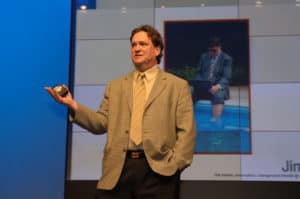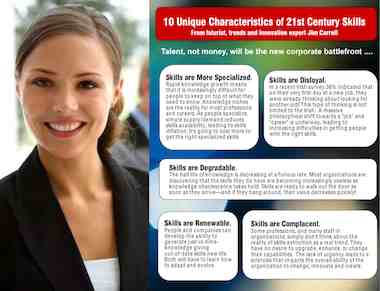I was in New Orleans two weeks ago, where I was a keynote speaker for Talent Strategies 2012.

The working title of my keynote was “Talent Management 2020: What Comes Next?“, with this description being provided to program attendees.
We live in an era of unprecedented, relentless change — a time of hyper-innovation, rapid skills obsolescence and the rapid emergence of new knowledge, constant career upheaval and evolution of existing careers and emergence of new careers. In an era such as this, every organization is faced with a need for a new type of talent management flexibility. That’s why some leaders are focused on “human capital agility”: the ability to deploy the right skills at the right time for the right purpose — just in time skills deployment. Whether it is dealing with the impact of faster rates of business model change, the rapid emergence of new markets and products, or more challenging organizational complexities, they are orienting themselves toward skills management as a key organizations success factor.
Join futurist, trends and innovation expert Jim Carroll as he shares his insight into the methods by which organizations are preparing for the changing economy of the 21st century through skills management strategies that focus on agility, insight and execution.”
I do an extensive number of talks about the future of the workforce and human capital issues; indeed, I’m thrilled to announce that I’ve been selected to open the 2012 HR Southwest Conference in October in Fort Worth, Texas – it is the largest regional human resources Conference in the United States – and will focus on a similar theme.
The folks over at Talent Strategies 2012 ran a conference blog, and had this to say about my keynote:
In keeping with the topic of change, futurist and trends and innovation expert Jim Carroll began the day’s second keynote session with this conundrum for human capital leaders to ruminate on: Seven out of 10 preschoolers will work in jobs or careers that don’t even exist today, so how can talent leaders plan for this?
The way Carroll described the velocity of change that’s occurring in our society and our organizations today can be likened to this analogy: Digital camera makers have barely three to six months to sell their gadget before it becomes obsolete. “This is a defining trend that’ll challenge our assumptions and show that we need to keep up in [the] human capital [space],” he said.
His speech was rife with forward-thinking — almost eerily futuristic — technological innovations that are or will become reality in the not-so-distant future. A connected thermostat that can be controlled from any location; a smartphone that’s also a credit card; and a therapeutic robotic animal were just a handful of examples he cited.
“We have to completely rethink what we’re doing with human capital because the same rules will not apply in the future,” he said. Yet, many or most HR leaders default to the mode of deferring decisions about future because of the uncertainty that exists in today’s economic environment. It’s what Carroll calls “aggressive indecision” when it comes to implementing talent strategies – “I’m not going to make decisions [regarding HR] because I don’t know when the economic recovery will occur. In the meantime, our competitors are making decisions that are going to position them for the future,” he said. Keeping up with the rapid pace of change, then, is good business sense because it helps organizations maintain a competitive advantage.
And with that mostly optimistic outlook, it’s in the hands of human capital leaders to become more proactive in creating the conditions for which the workforce of the future can thrive.

In my keynote, I focused on the theme of 10 Unique Characteristics of 21st CenturySkills – which provides a concise overview of just how differently we have to treat the issue of human capital and talent going forward. There’s a nice PDF summary that you can grab through the image.
What are the key issues? In essence, there are a variety of human capital issues that you should be thinking about:
- Experiential Capital. In a world in which Apple generates 60% of its revenue from products that didn’t exist four years ago, it’s critically important that an organization constantly enhance the skill, capabilities and insight of their people. They do this by constantly working on projects that might have an uncertain return and payback – but which will provide in-depth experience and insight into change. It’s by understanding change that opportunity is defined, and that’s what experiential capital happens to be. In the future, it will be one of the most important assets you can possess.

- Skills Accessibility Capital. Talent, not money, will be the new corporate battlefront. Simply put, there is so much happening that no one person or organization can know everything there is to know. With ongoing rapid knowledge growth, instant market change, fast-paced scientific discovery and constant skills evolution, getting the right people at the right time for the right purpose will be the key to successful change.
- Creativity Capital. It is the ability to see the world differently, and the skill to imagine how to do things differently, that will be more important than any other skill. This will bring the needed forward oriented depth that organizations require. When product lifecycles are disappearing, and market longevity is measured in weeks and months, the ability to think, adapt, and imagine will be the foundation to provide for necessary change.
- Generational Capital. We are set to see the emergence of the most unique workforce in history, with the widest age-span ever. Boomers won’t retire, and kids won’t want to get hired. The result will be a workforce that is transient, temporary, shifting and flexible. It will be those organizations who can match up the experience and wisdom of the aging baby boomers with the insight, enthusiasm and change-adept younger generation who will find the most powerful force to be found in business – an organization that is fuelled by the pure energy of change-oxygen.
- Collaborative Capital. Forget the idea of having a strategic planning department, and think collaborative culture instead. Take a look around you, and ask yourself, who is succeeding today? It is those organizations who are plugged into the infinite idea loop that surrounds us. They’ve dropped any pretense that they can create the future, and instead realize that the future is being devel-oped by everyone all around them. They have come to learn that their role isn’t to plan for that future, but simply to listen to it, plug into it, and plug their growth-engine into it.
- Complexity Partnership Capital. In the 20th century, organizations focused on hiring the skills that they needed to get the job done. You simply can’t do that today – skills are too fragmented and too specialized. That’s why successful organizations have mastered the art of complexity supply and demand. They provide their own unique complex skills to those of their partners who need such skills. And when they are short on other skills, they tap into the skills bank of their partners. By selling and buying skills with a broad partnership base, they’ve managed to become complexity partners – organizations that spend most of their time focusing on their core mission, and spend less time worrying about how they are going to do what they need to do.
- Innovation Capital. Companies that understand that all future innovation comes from the ability to tap into the global innovation loop will thrive; those that follow traditional innovation models, self-centered and insular, will find that their creativity and uniqueness has been smothered.
I think my talk was effective, with one Tweet noting: “Talent Strategies: @jimcarroll is killing it. Great discussion on change, innovation, the future of work, & the evolution of jobs. #strat12”.





GET IN TOUCH
Jim's Facebook page
You'll find Jim's latest videos on Youtube
Mastodon. What's on Jim's mind? Check his feed!
LinkedIn - reach out to Jim for a professional connection!
Flickr! Get inspired! A massive archive of all of Jim's daily inspirational quotes!
Instagram - the home for Jim's motivational mind!